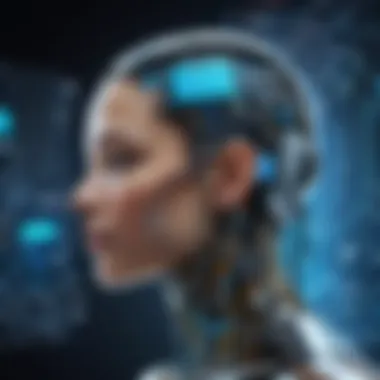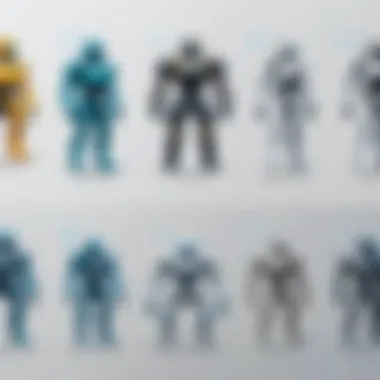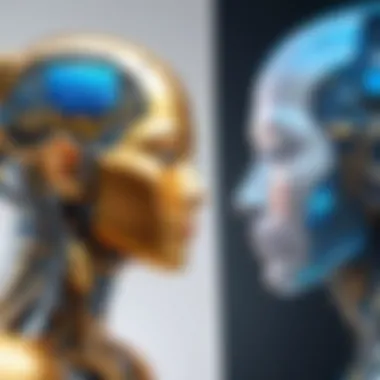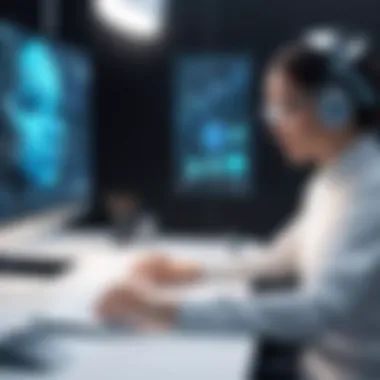The Evolution of AI in Drawing: Technologies and Trends


Intro
The integration of artificial intelligence into drawing has transformed the way artists approach their craft. The advancements in technology are reshaping creative processes, allowing for innovative methods and applications that were once unimaginable. Understanding these developments is crucial for professionals within IT and creative fields alike as they navigate the evolving landscape.
This examination will reveal how AI-driven tools leverage machine learning algorithms and neural networks to analyze, replicate, and enhance artistic styles. From professional illustrators to casual hobbyists, the implications of AI in drawing are far-reaching. As we delve deeper, we will uncover the significant trends shaping the future and the ethical considerations surrounding these technologies.
By exploring key features of prevalent AI drawing tools, analyzing performance data, and discussing real-world applications, this analysis aims to provide a comprehensive overview tailored for an informed audience.
Product Overview
In the realm of AI drawing technology, various products stand out due to their unique capabilities. These tools have evolved to assist artists in improving their work while also providing unique outputs that reflect various artistic styles.
Key Features
Some central attributes of effective AI drawing tools include:
- Style Transfer: Ability to apply the visual appearance of one image to another, creating compositions that blend styles seamlessly.
- Image Generation: Tools that generate new images based on user inputs, often producing unique and unexpected results.
- Editing Capabilities: AI that assists in refining sketches or enhancing details, making revisions faster and more precise.
- Learning Algorithms: Continuous improvement of drawing suggestions based on user feedback and prior outputs, adapting to an individual artist's preferred style.
Technical Specifications
When considering a drawing tool, understanding its technical specifications is vital:
- Model Architecture: Many use Generative Adversarial Networks (GANs) to produce images that are convincingly realistic.
- Training Datasets: The size and quality of datasets used directly influence the output quality. Some platforms utilize extensive art databases, enhancing their understanding of various art forms.
- User Interface: Most tools offer intuitive interfaces that allow for easy navigation, integrating complex features for smooth user experience.
Performance Analysis
An in-depth analysis of these tools reveals their effectiveness in real-world settings.
Benchmark Test Results
Performance benchmarks can illustrate the capabilities of these AI systems. Various studies show that:
- Tools like DeepArt and DALL-E frequently achieve high accuracy in style transfer, often surpassing traditional software in time efficiency.
- AI-generated images from platforms like Artbreeder and Runway are increasingly indistinguishable from those created by human artists.
Real-World Usage Scenarios
The practical applications of AI drawing technologies span multiple fields:
- Professional Art Creation: Artists utilize these tools for inspiration, experimentation, and even final pieces, combining AI outputs with their vision.
- Marketing and Content Production: Companies employ AI-generated illustrations for branding, social media, and advertising, optimizing costs and time.
- Game Development: Developers incorporate AI technologies to automate asset creation, allowing for more creative freedom in design.
"The intersection of AI tech and artistry is not merely an evolution; it is a revolution, redefining creativity as we know it."
Prelims to AI in Drawing
The field of drawing has recently experienced a dramatic transformation due to the advent of artificial intelligence (AI). This change is not merely technological; it has broader implications for creativity, artistry, and the role of the artist. As we initiate this comprehensive discussion, it is essential to recognize why understanding AI's role in drawing is crucial today.
Firstly, AI tools are fundamentally changing how artists approach their craft. These innovations can automate specific tasks, allowing artists to concentrate on more complex creative decisions. Furthermore, AI-driven applications have expanded the means of expression available to artists. They open new avenues for collaboration, where human intuition can intertwine with machine precision.
Secondly, this examination reveals the necessity of considering the ethical aspects of AI in artistic endeavors. Questions surrounding ownership, originality, and the nature of creativity itself arise when machines produce works of art. These discussions are vital for artists and technologists alike, as they redefine the lines between human and artificial contributions to art.
In essence, this exploration aims to distill a nuanced understanding of how AI technologies not only assist in the drawing process but also shape its very future.
Understanding AI Drawing Technologies


To fully grasp the implications of AI in drawing, one must first appreciate the core technologies at play. AI drawing tools are powered by a range of methodologies, mainly derived from machine learning and neural networks.
Machine Learning is a subset of AI that focuses on the development of algorithms that can learn from and make predictions based on data. This learning process enables the creation of systems that can recognize patterns, leading to advancements in drawing technology.
Neural Networks simulate the human brain's interconnected neuron structures. They can analyze images, understand various styles, and even generate new drawings based on learned principles.
The combination of machine learning and neural networks has given rise to applications that can mimic human artistic styles or create entirely novel visual representations. Artists and designers are leveraging these tools to enhance their workflow and to innovate their artistic practices.
Historical Context of AI in Art
Understanding the evolution of AI in drawing requires a look back at the historical context. Early experiments with computer-generated art began in the 1960s. Artists like Frieder Nake and Harold Cohen began exploring how computers could aid in artistic creation, although the results were often rudimentary due to limited computing power.
As technology advanced through the decades, the emergence of personal computers in the 1980s gave rise to more complex software programs aimed at artists. Programs like Adobe Illustrator and CorelDRAW became staples for graphic designers, setting the stage for more innovative applications.
In the early 21st century, the rise of deep learning techniques, particularly convolutional neural networks, began to revolutionize the field of AI art. The introduction of frameworks like TensorFlow and PyTorch allowed developers to create sophisticated models capable of generating high-quality images. This historical evolution reflects a growing recognition of the potential AI holds in the realm of artistic expression.
In summary, AI has not only influenced how art is created but has also played a significant role in expanding our understanding of creativity itself. Through this exploration, we uncover the foundational elements that drive today's AI drawing technologies.
Core Technologies Behind AI Drawing
Core technologies behind AI drawing are critical to understanding the transformation in the art and design landscape. These technologies leverage advanced computational methods to create visual content that pushes the boundaries of creativity. They also open up new avenues for artists and designers, enabling them to explore innovative concepts in a faster and more efficient manner. Understanding these technologies is essential for grasping the full implications of AI in the artistic domain.
Machine Learning Algorithms
Machine learning algorithms form the backbone of AI drawing tools. These algorithms enable machines to learn from data and improve over time. They analyze patterns and structures within existing artwork to generate new pieces that reflect similar or novel styles. This capability significantly enhances the productivity of artists, providing them with tools that can assist in their creative processes. Moreover, machine learning allows for the personalization of artwork, as it can adapt to individual artist preferences. Yet, the reliance on these algorithms raises questions about originality and the influence of human creativity in the art-making process.
Neural Networks in Image Generation
Neural networks play a pivotal role in image generation within AI drawing technologies. They are designed to mimic the human brain's functionality, consisting of interconnected nodes that process information. The application of neural networks can be categorized into different types, notably Convolutional Neural Networks (CNNs) and Generative Adversarial Networks (GANs).
Convolutional Neural Networks (CNNs)
Convolutional Neural Networks (CNNs) excel in processing visual information, making them an ideal choice for AI-driven drawing tools. The primary characteristic of CNNs is their ability to recognize patterns and features in images through the convolution operation. This feature allows them to identify shapes, textures, and other elements critical in artistic creation.
One of the unique advantages of CNNs is their efficacy in analyzing large datasets of images. They can learn from thousands of existing artworks and generate new visuals that maintain stylistic consistency. However, while CNNs are powerful, they require significant computational resources and carefully curated datasets to yield high-quality results. Thus, their implementation might come with cost and performance considerations.
Generative Adversarial Networks (GANs)
Generative Adversarial Networks (GANs) present another significant advancement in the realm of AI drawing. GANs consist of two neural networks—the generator and the discriminator—working in tandem. The generator creates images, while the discriminator evaluates their quality. This interplay gives GANs a distinct edge in producing highly-realistic outputs.
A key feature of GANs is their ability to generate unique and diverse art pieces. They can produce variations of existing styles or combine multiple influences to create something entirely new. However, GANs are not without challenges. They can be unstable during training and might require extensive tuning to achieve desirable results. Despite these hurdles, GANs have become popular in various artistic applications due to their capacity for high-quality image synthesis.
Applications of AI in Drawing
The applications of artificial intelligence in drawing represent a transformative aspect of this technology. The importance of these applications lies in their capacity to enhance creativity, efficiency, and accessibility across diverse fields. AI tools can automate processes that traditionally require a high degree of skill and labor, allowing artists and designers to focus on higher-level creative concepts. These applications can also democratize art and design, making it easier for individuals without formal training to create visually compelling content. Furthermore, AI solutions offer innovative methods for integrating artistic production with technology, ushering in new professional opportunities.
Commercial Use in Advertising
AI technologies in advertising have reshaped how brands communicate with consumers. From generating eye-catching visuals to creating personalized content, AI assists in crafting targeted advertising campaigns at scale. For instance, tools like Daz 3D and DeepArt employ machine learning to produce unique visual styles tailored to specific audiences. These tailored images enhance engagement, promoting brand loyalty more effectively than traditional methods.
The commercial landscape benefits significantly from AI's efficiency. By analyzing large sets of consumer data, AI identifies trends and preferences that inform creative decisions, ensuring projects resonate with target demographics. This alignment increases return on investment, making AI a crucial asset for marketers aiming to refine their approach and achieve results in fast-paced environments.
AI-Assisted Graphic Design
Graphic design is another area where AI has made a substantial impact. Platforms such as Canva and Adobe Sensei provide automation features that streamline design workflows. With AI assistance, designers can generate layouts, select color palettes, and even edit photographs quickly. This efficiency allows designers to experiment more, explore various creative avenues, and ultimately produce better results in less time.


The rise of AI in graphic design does not eliminate the need for human touch. Instead, it enhances the designer's toolkit, allowing for improved collaboration between artificial intelligence and human creativity. Designers can focus on the conceptual aspects of their work, leaving repetitive tasks to AI-driven tools. Such collaboration enables the production of visually stunning content while maintaining the unique attributes that only a human eye can offer.
Entertainment and Media
In the entertainment industry, AI technologies are garnering attention for their ability to revolutionize how content is created and consumed. AI's role in this sector stretches from animation production to video game development.
Animation and Film Production
Animation has benefitted immensely from AI innovations. Tools like Runway and Artbreeder assist animators by generating lifelike characters and environments based on initial sketches. This expeditious workflow allows studios to meet increasing consumer demands for content without sacrificing quality.
The unique feature of AI in animation is its capability to streamline labor-intensive tasks such as motion capture and frame interpolation. Consequently, productions can allocate resources to more complex storytelling elements or creative enhancements. The main advantage is evident: faster production times and more cost-effective solutions. However, this method raises questions about the potential dilution of artistic originality.
Video Game Development
Video game development is another field significantly impacted by AI. The technology aids in generating realistic graphics and dynamic game environments. AI methods can autonomously create vast landscapes, intricate character designs, and adaptable gameplay mechanics, all enhancing the user experience.
A notable characteristic of AI in video games is procedural generation. This technique allows developers to create content algorithms that dynamically adjust based on player actions. As a result, each player's experience can be unique, increasing replay value. While this method promotes innovation, it also poses a challenge related to ensuring balance and fairness within the gaming environment.
Impact on Traditional Art Practices
The impact of artificial intelligence on traditional art practices cannot be underestimated. The introduction of AI technologies has altered the landscape of artistry, bringing both opportunities and challenges. Artists today must navigate a new environment where machines can generate images, design, and even create ineffable art pieces. This shift raises critical questions about the role of the human artist and the nature of creativity itself.
Collaboration Between AI and Artists
Collaboration between AI and artists is a pivotal aspect of the evolving art world. Artists are beginning to harness AI not merely as a tool but as a collaborator. For instance, platforms such as DALL-E enable artists to input ideas and concepts, which are then visualized using advanced neural networks. This blending of human ingenuity and machine learning can result in unique artistic expressions that would be difficult to achieve otherwise.
The partnership between AI and artists can stimulate creativity. Some artists appreciate the ability to explore new ideas quickly, using AI to push their own boundaries. They can produce variations of a piece with different styles or elements that they where previously unable to imagine. This integration encourages experimentation and innovation.
However, some may worry that reliance on AI might dilute the essence of human creativity. Critics argue that creating art is inherently about the human experience – feelings, perceptions, and emotions. If an artwork is produced with significant input from AI, they question who deserves credit for the resulting piece. As artists engage in this new realm, they may need to reevaluate their processes and the meaning of their work.
Challenges Faced by Traditional Artists
Traditional artists are faced with numerous challenges in a world increasingly influenced by AI. One significant problem is the potential loss of market share. As AI-generated art becomes more popular and accessible, there is a danger that unique human-created art may be undervalued. AI can produce art at an incredible speed and lower cost, which could lead some consumers to favor these options over traditional methods.
Additionally, the rapid advancement of AI technologies creates a steep learning curve for artists. Those who are unwilling or unable to adapt may find themselves sidelined. Learning to work with AI tools requires time and training, which may not be feasible for everyone. Artists may feel pressured to learn new technologies to keep pace with industry demands, potentially overshadowing their core skills.
Finally, there are ethical considerations to navigate. The attribution of artistic ownership raises complex questions. If an AI program generates an artwork, who retains the copyright? Important discussions are beginning around these issues, as traditional artists must consider how AI tools alter the concepts of authorship and authenticity.
"AI can be a partner, a tool; however, the essence of art remains the human touch."
The impact of AI on traditional art practices is profound. It marks a distinct shift in how art is produced, valued, and understood. Artists are at a crossroads, with opportunities for collaboration and expression, yet also facing significant challenges. As they adapt to this new reality, the dialogue between technology and creativity continues to unfold.
Ethical Considerations in AI Art
The rise of AI technologies in the drawing and art sectors brings about significant ethical considerations. Understanding the implications of AI's role in creativity is essential. This is particularly true in areas such as copyright, ownership, authenticity, and the definitions of value in art. Critics argue that AI-generated art may undercut human creativity, whereas proponents point to potential benefits for artists in terms of collaboration and expansion of possibilities.
Notably, the discussions around ethical considerations also pertain to inclusivity in the art community. Technologies that facilitate drawing through AI have a varying impact on different groups of artists and creators. Recognizing these facets is vital as we navigate the evolving landscape of art in an AI-driven world.
"With the blending of technology and creativity, we must address moral responsibilities in our creative expressions."
Copyright Issues and Ownership of AI-generated Work
One of the most pressing issues related to AI in drawing is copyright. Traditional copyright law often considers the human artist as the creator, holding rights to their work. When AI generates art, the question arises: Who owns the resulting pieces? The programmer, the user of the AI system, or is it the machine itself?


Here are the key points surrounding this debate:
- Lack of Clarity: Current laws do not specifically address AI as an author, creating ambiguities.
- Ownership Claims: Different stakeholders may claim ownership for the output of the AI, leading to potential disputes.
- Legislation Response: Countries like the United States and the European Union are considering how to adapt copyright laws to include AI-generated art.
These factors necessitate ongoing discussions about intellectual property rights and the reformation of existing laws to protect both human and AI creations.
Authenticity and Value in Art
The authenticity of art has traditionally been a metric of its value. However, with AI's ability to mimic styles and produce impressive pieces without human intervention, defining „authentic” art becomes complex. Here are aspects to consider:
- Value of Creation: The emergence of AI-generated art raises questions about intrinsic value. Is a painting made by a machine less valuable than one created by human hands?
- Artistic Intention: Art often carries the intent and emotions of the artist. The challenge with AI is that it works based on algorithms without genuine sentiment. Does this affect its value?
- Market Reception: Collectors and critics are starting to engage with AI art. It will be interesting to observe how this shifts market attitudes, both positively and negatively.
As we ponder these questions, the discourse on authenticity in art continues to evolve, shaping opinions about AI's place in the creative world.
Future Directions of AI in Drawing
The future directions of AI in drawing present significant implications for artists, designers, and technologists alike. As developments in algorithms and computing power continue, these trends will shape how we view creativity and the role of machines in artistic practices. Understanding these directions is crucial to comprehend the likely changes in both technology and society. AI is not merely an enhancement tool; it has the potential to redefine the essence of art itself.
Advancements in Algorithmic Capabilities
Advancements in algorithmic capabilities will drive the evolution of AI in drawing. These improvements allow for more sophisticated image generation techniques. For instance, existing algorithms are becoming better at interpreting artistic styles and mimicking human creativity.
With innovations such as deeper neural networks and hybrid models, AI systems can learn from vast datasets more effectively. This leads to:
- Enhanced realism in generated artworks.
- Improved ability to differentiate between styles and mediums.
- Greater adaptability in producing unique visual content based on user inputs.
As we expect these capabilities to improve, artists might find new forms of collaboration with AI technologies. Fewer limitations mean that creativity can flourish in unprecedented ways. This evolution calls for a re-examination of what constitutes originality.
Integration with Augmented and Virtual Reality
The integration of AI drawing tools with augmented reality (AR) and virtual reality (VR) signifies a pivotal shift in interactive art experiences. Artists can use these mediums to produce immersive environments, occupying a new space where physical and digital art collide.
- Potential Applications: Artists can create dynamic installations that respond to viewer interactions. For instance, when a person engages with AR art, they might influence the graphical elements displayed.
- User Experience: This technology fosters a more engaging experience, attracting audiences who seek interaction. They can create and manipulate digital art directly in their environments.
As AR and VR platforms evolve, artists will need to adapt their techniques and profound understanding of spatial design. New opportunities will emerge to influence how art is created, experienced, and shared.
Potential Disruptions in Art Communities
As AI continues its integration into the creative sectors, it can disrupt traditional art communities significantly. While some potential impacts are constructive, others may raise concerns.
- Commercialization of Art: AI's ability to produce art quickly and at scale threatens to saturate the market. This could lead to reduced value for human-made art and a shift in consumer preferences.
- Shift in Skill Relevance: For emerging artists, skills in traditional drawing may become less relevant. Learning to collaborate with AI may become essential, which might challenge classical art education methodologies.
- Accessibility versus Authenticity: More people may become creators through AI tools, democratizing art. However, the question of authenticity will arise. What does it mean for art when the creator is not solely human?
The future of AI in drawing is complex and multi-faceted. It brings both challenges and opportunities to various stakeholders in the art world. As AI refines itself and resonates with human creativity, the implications will necessitate ongoing discussions and adaptative strategies in art practices. Understanding these trends will help navigate the forthcoming transformations more effectively.
Closure
The rapid progression of AI technologies has significantly transformed the landscape of drawing and illustration. This article provides a structured exploration of the multifaceted role AI plays in the creative field. The conclusion underscores essential components, shedding light on the importance of understanding these innovations.
Summary of Key Insights
AI's integration into drawing not only enhances creative capabilities but also opens new avenues for artistic expression. Key insights include:
- AI drawing tools leverage machine learning and neural networks to generate high-quality imagery.
- Applications in commercial contexts, such as advertising and graphic design, highlight the economic potential of AI-assisted art.
- The collaboration between AI and traditional artists illustrates a growing synergy, where human intuition and machine efficiency meet.
- Ethical considerations regarding copyright and authenticity challenge the conventions of art ownership.
- Future trends suggest greater integration with augmented and virtual reality, offering immersive experiences that were previously unattainable.
These insights emphasize that AI's role in drawing is not merely about replacing human efforts but rather augmenting them by offering new tools and mediums.
Final Thoughts on AI's Role in Drawing
As AI technologies evolve, so too must our understanding of their implications in the creative industries. AI is set to redefine what it means to create art, instigating discussions about the nature of creativity itself. Artists and technologists alike stand to benefit from embracing these advanced methods, contemplating both the possibilities and the challenges they introduce.
The art community faces a fascinating future where traditional practices intersect with technological innovations. By prioritizing dialogue around ethical standards and fostering collaboration between creators and machines, society can harness the best of both worlds. Ultimately, AI's contribution to drawing signifies a new chapter in artistic exploration, pushing boundaries toward uncharted territories in visual creativity.



